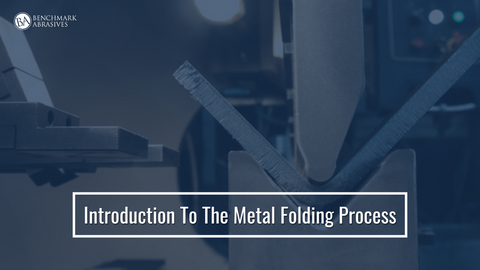
Introduction To The Metal Folding Process

Metal folding, or bending, is the fundamental process used in sheet metal fabrication to give a flat sheet its final, functional 3D shape, from simple brackets to complex enclosures. Achieving the desired angle and tolerance requires selecting the right method. This guide breaks down the five core metal folding techniques used by fabricators to ensure precision and integrity.
Metal Folding Process Fundamentals
Metal folding involves shaping the sheet metal without causing material fracture or damage. This is achieved by using a machine—most often a Press Brake—to apply stress that exceeds the material's yield strength (the point at which it begins to permanently deform) but stays below its tensile strength (the point at which it will tear apart).
To obtain various shapes, workers utilize specialized die sets and often employ CNC (Computer Numerical Control) machines for high-precision, repeatable results.
Critical Concepts: Bend Allowance and Radius
A successful bend is not just about the angle; it's about the final dimension of the part. This relies on two key factors:
- Inner Bending Radius: This is the curve formed on the inside of the bend.
- Bend Allowance: The measured length of the metal along the actual bend is known as the bend allowance. If this value is incorrect, the final part will be too long or too short. Fabricators must account for the metal that gets consumed during the bend to ensure the flat piece (the blank) is cut to the correct starting size.
Effective Metal Folding Techniques
The choice of technique often comes down to the required accuracy, the thickness of the material, and the production volume.
1. Air Bending
A punch is used in air bending to press the sheet metal into a bottom die with a V aperture. Crucially, the metal only makes three points of contact: the tip of the punch and the two edges of the V-shaped die. The punch does not push the metal all the way to the bottom of the die, leaving an "air gap."
The desired angle is determined by how deeply the punch is pushed into the die.
- Springback: A significant factor in air bending is Springback. This is the material's elastic memory, which causes it to return slightly toward its original flat position after the punch is released. To achieve a 90-degree angle, the operator must deliberately over-bend the material (e.g., bend it to 88 degrees) to compensate for this return.
- Advantages: This is the most popular method due to its low tonnage requirement and flexibility—a single die can be used for various angles and materials.
2. Bottom Bending
Bottom bending is similar to air bending, but the punch forces the sheet metal completely into contact with the bottom V-die. The process name comes from the metal coming into contact with the lower end (the "bottom") of the V-opening die.
Because the punch and die compress the material entirely, bottom bending is significantly more precise and less susceptible to the effects of springback than air bending. However, it requires a much greater tonnage (force) from the press brake, and you must use specialized dies that match the precise angle you are trying to achieve. In other words, the die must be changed frequently for different angles.
3. Coining
Coining is a closed-die process that requires the highest amount of pressure. The machine effectively stamps the sheet metal in the space between the punch and the die, physically altering the material's thickness in the bend area.
-
Advantages: This extreme pressure virtually eliminates springback, resulting in extremely precise angles and easier repeatability. It also compresses the metal's grain structure, creating a harder, smoother surface that often eliminates the need for additional finishing steps. It can be performed on gear-driven, mechanical, or hydraulic presses.
4. Wiping Die Bending (Edge Bending)
Also known as edge bending, this method pushes the sheet metal up against the die's edge, bending it to the desired angle. The piece of metal is secured against a pad and die. A wiping flange then moves across the portion of sheet metal that sticks out, folding it over the edge of the die.
A lower shoe supports the die, while an upper shoe holds and controls the flange. The spring located between the pad and the upper shoe keeps the metal in place as it is bent. Adjusting the flange and die allows you to precisely control the bend angle, and modifications can even enable the creation of radius bends.
5. Rotary Bending
Rotary bending is most common for pipes, but is also suitable for large or heavy sheets that would otherwise raise safety or labor issues. The material is bent using a stationary die adjusted to virtually any angle required.
Rotary bending is incredibly flexible and is often utilized because it can bend metals beyond a 90-degree bend—in rare cases, up to 180 degrees. It is also considered a cost-effective technology because it consumes more than 50% less tonnage than coining or bottom bending and often incurs lower labor costs.
| Folding Method | Tonnage Required | Precision / Springback | Flexibility (Angles per Die) |
| Air Bending | Low | Lower (High Springback) | Very High (Multiple angles) |
| Bottom Bending | High | High (Low Springback) | Low (One angle per die) |
| Coining | Highest | Highest (Zero Springback) | Low (One angle per die) |
Key Learnings
Selecting the correct metal folding process for metal fabrication depends on the job's requirements. Use coining if you need maximum repeatability and precision. For general-purpose work with low setup cost, air bending is the default. Always use high-quality metal to ensure a decent folding process produces reliable results.
Benchmark Abrasives is a leading manufacturer and supplier of abrasive products for the metal and woodworking industries. We offer a range of products, including abrasive belts, discs, sheets, and rolls. For more, visit our store now!



































































